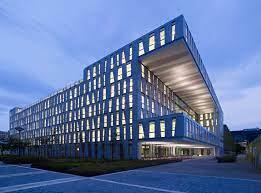In the first half of 2021, tenants leased over 1.1 million m2 of modern office space across the capitals of the 15 CEE countries. The highest level of activity was recorded in Warsaw (249,300 m2), followed by Prague and Budapest. The Business Services Sector continues to generate a great deal of demand and occupier activity and is one of the largest employment sectors in the region according to the “ExCEEding Borders - Office Markets & Business Services in CEE-15” “ report recently released by Colliers.
Office Stock in CEE - H1 2021
The total modern office stock in the 15 CEE capital city markets covered in this report, reached over 29 million m2 at the end of H1 2021. New office supply in these markets during the first half of 2021 totalled just over 640,000 m2, with a further 2.2 million m2 currently under active development and due for delivery over the next 2-3 years.
Demand for modern office space
Kevin Turpin, Regional Director of Research for CEE at Colliers explains: “As a result of recent disruptions related to the pandemic, the biggest office markets in CEE in 2020 saw a YoY declines of up to -30% on average in both Gross and Net demand. The first half of 2021 has seen similarly subdued results, however, some markets, including Warsaw, have started to see green shoots of recovery. In the first half of 2021, tenants leased over 1.1 million m2 of modern office space across the capitals of the 15 CEE countries. The highest level of activity was recorded in Warsaw (249,300 m2), followed by Prague (183,300 m2) and Budapest (172,900 m2).
“It is important to highlight that a great deal of demand, or occupier activity, across the CEE markets comes from the modern business services sector which is among the largest office occupier groups. To give an indication of how important or how large this sector is, if we assume an average of 10 m2 per employee, then the sector could occupy well in excess of 10 million m2, or the equivalent of ca. 35% of the 15 CEE capital city market stock. The spread of these BSS centres however is of course much wider than the capital city markets, particularly in the regional markets of Poland, Czech Republic and Romania” adds Kevin.
The supply of modern office space
The largest supply of modern office space is located in Warsaw (ca. 6.1 million m2), Budapest (ca. 4 million m2) and in Prague (3.7 million m2). The largest increase of new supply in H1 2021 was noted in Warsaw where developers delivered 10 office projects with a total area of 226,300 m2. Looking ahead, the largest volume of new, modern office space under construction at the end of H1 2021 was in Budapest (350,000 m2), Warsaw and Sofia.
Vacancy rates
The widest choice of available office space at the end of H1 2021 was noted in Sarajevo (30%), Tirana (16.5%) and Sofia (16%) following sizeable new deliveries relative to the size of these markets. The lowest vacancy rates at the end of H1 2021 were recorded in Ljubljana (4%), Zagreb (5%) and Tallin (7.3%).
Tamas Steinfeld, Head of Research at Colliers Hungary comments: “The speculative vacancy rate in Budapest by the end of H1 was still the second lowest among the CEE regional capitals with 11.7% followed by Prague with 7.8%. This is more of a remarkable jump from the all-time low of 6.7% by the end of 2019 in Budapest. This increase is mainly attributable to the more significant new supply handed over during this period compared with the previous years and simultaneously the more modest demand, due to the uncertainties in relation to the coronavirus. Furthermore, companies had a wait and see approach during this period to assess their future office needs in light of the new home office scheme, which requires occupiers to re-think their approach for office areas both in terms of lay-out and required size in long term.”
Business Services
For many countries in the region, business services have become one of the leading sources of FDI and one of the biggest employment sectors, now estimated to employ well in excess of
1 million people in the markets covered in this report.
Elias van Herwaarden, Head of Location Strategy for EMEA at Colliers comments: “Although the double-digit annual employment growth in the sector in many countries has reportedly slowed in recent times to mid to high single digits, the CEE region is still attracting new investment and seeing the expansion of existing centres. This success, which is set to continue for many years to come, is largely thanks to the regions labour pool of well-educated and highly talented people with a very broad range of language skills”.
From office to social anchor
Elias adds: “BSCs have done well in taking-on additional work from their corporate front-lines throughout the pandemic. But off the record, many of their leaders will admit “it all worked better and faster” during the days that they could have people brainstorming face-to-face in a room for a day or two. There is also the matter of talent management. The more successful BSCs typically put significant effort into company branding and increasingly lavish chill-out spaces and workplaces to create a team feeling and a sense of belonging”.
Marius Ivanauskas, Head of Group Business Services at Telia Company comments: “Work will never be the same as it became detached from physical location, however companies need common denominators to ensure they keep people within their gravity field - one of those will be the office as social anchor.”
Colliers








